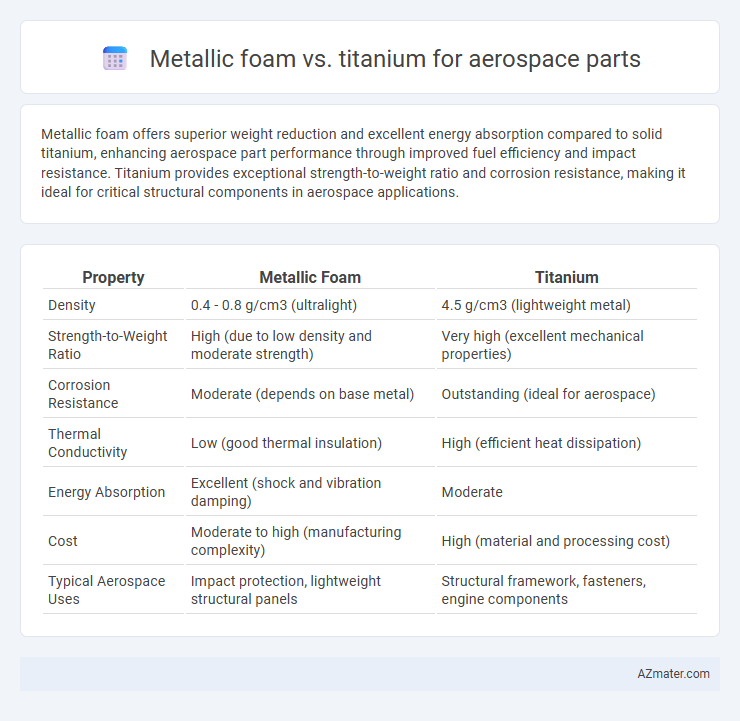Metallic foam offers superior weight reduction and excellent energy absorption compared to solid titanium, enhancing aerospace part performance through improved fuel efficiency and impact resistance. Titanium provides exceptional strength-to-weight ratio and corrosion resistance, making it ideal for critical structural components in aerospace applications.
Table of Comparison
| Property | Metallic Foam | Titanium |
|---|---|---|
| Density | 0.4 - 0.8 g/cm3 (ultralight) | 4.5 g/cm3 (lightweight metal) |
| Strength-to-Weight Ratio | High (due to low density and moderate strength) | Very high (excellent mechanical properties) |
| Corrosion Resistance | Moderate (depends on base metal) | Outstanding (ideal for aerospace) |
| Thermal Conductivity | Low (good thermal insulation) | High (efficient heat dissipation) |
| Energy Absorption | Excellent (shock and vibration damping) | Moderate |
| Cost | Moderate to high (manufacturing complexity) | High (material and processing cost) |
| Typical Aerospace Uses | Impact protection, lightweight structural panels | Structural framework, fasteners, engine components |
Introduction to Aerospace Materials
Metallic foam offers a lightweight structure with high energy absorption and excellent thermal insulation, making it advantageous for aerospace components where weight reduction is critical. Titanium provides superior strength-to-weight ratio, corrosion resistance, and high-temperature performance, essential for structural parts subjected to severe mechanical stress. Selecting aerospace materials depends on balancing weight, mechanical properties, and environmental resistance to optimize aircraft efficiency and durability.
Overview of Metallic Foam
Metallic foam offers a unique combination of lightweight structure and high strength, making it ideal for aerospace applications where weight reduction is critical. Its porous composition provides excellent energy absorption and thermal insulation properties, outperforming solid metals like titanium in specific impact resistance scenarios. The material's ability to be tailored in terms of density and pore size allows engineers to optimize aerospace components for enhanced durability and fuel efficiency.
Properties of Titanium in Aerospace
Titanium is highly valued in aerospace due to its exceptional strength-to-weight ratio, corrosion resistance, and ability to withstand extreme temperatures. Its biocompatibility and fatigue resistance enable the production of durable, lightweight aircraft components. Compared to metallic foam, titanium offers superior structural integrity and thermal stability essential for critical aerospace applications.
Weight Comparison: Metallic Foam vs Titanium
Metallic foam offers a significant weight advantage over titanium, with densities typically ranging from 0.4 to 2 g/cm3 compared to titanium's density of approximately 4.5 g/cm3. This reduction in weight can lead to improved fuel efficiency and increased payload capacity in aerospace applications. Despite its lower density, metallic foam maintains sufficient structural integrity, making it an attractive lightweight alternative to traditional titanium parts.
Strength and Durability Factors
Metallic foam offers exceptional strength-to-weight ratios, making it ideal for lightweight aerospace components, while titanium excels in tensile strength and fatigue resistance, crucial for high-stress parts. Titanium's superior durability under extreme temperatures and corrosive environments outperforms metallic foam in long-term structural integrity. Selecting between the two depends on balancing the lightweight advantage of metallic foam against titanium's robust strength and durability for aerospace applications.
Corrosion Resistance in Aerospace Environments
Metallic foam offers enhanced corrosion resistance due to its oxide layer and porous structure, which dissipates stress and reduces crack propagation in aerospace environments. Titanium is highly corrosion-resistant as well, favored for its ability to form a stable titanium oxide layer that withstands harsh atmospheric conditions and salt spray exposure. Compared to metallic foam, titanium typically provides superior long-term durability in aerospace applications where corrosion resistance is critical.
Manufacturing Processes and Costs
Metallic foam offers significant weight reduction and energy absorption benefits compared to solid titanium, but its manufacturing processes, such as powder metallurgy and foaming techniques, are often more complex and less mature, leading to higher production variability and costs. Titanium components typically involve well-established processes like machining, forging, and additive manufacturing, which provide consistent mechanical properties but come with higher material and processing expenses. In aerospace applications, selecting between metallic foam and titanium depends on balancing the lightweight advantages against the precision, reliability, and cost-efficiency of manufacturing methods.
Thermal and Acoustic Insulation Capabilities
Metallic foam exhibits superior thermal insulation properties compared to titanium due to its porous structure, which significantly reduces heat transfer in aerospace components. Its cellular architecture also enhances acoustic insulation by dampening sound vibrations and minimizing noise levels inside aircraft cabins. While titanium offers excellent strength-to-weight ratios, metallic foam provides a balanced combination of lightweight, thermal barrier efficiency, and sound absorption critical for aerospace part performance.
Current Applications in Aerospace Industry
Metallic foam offers significant weight reduction and impact energy absorption, making it suitable for aerospace applications such as soundproofing panels, crash protection, and lightweight structural components. Titanium remains the material of choice for critical aerospace parts like engine components, airframe structures, and landing gear due to its exceptional strength-to-weight ratio, corrosion resistance, and high-temperature performance. Current aerospace industry trends leverage metallic foam primarily in non-critical zones for enhanced durability and noise reduction, while titanium dominates load-bearing and high-stress applications.
Future Trends and Research Directions
Metallic foams, known for their high strength-to-weight ratio and energy absorption capabilities, are emerging as promising materials for lightweight aerospace components, while titanium maintains dominance due to its superior corrosion resistance and mechanical properties. Future research is focusing on hybrid structures combining metallic foams with titanium alloys to optimize fatigue resistance and thermal stability under extreme aerospace conditions. Advances in additive manufacturing and nano-engineering aim to tailor pore architecture in metallic foams, enhancing their integration with titanium parts for next-generation aerospace applications.

Infographic: Metallic foam vs Titanium for Aerospace part
 azmater.com
azmater.com